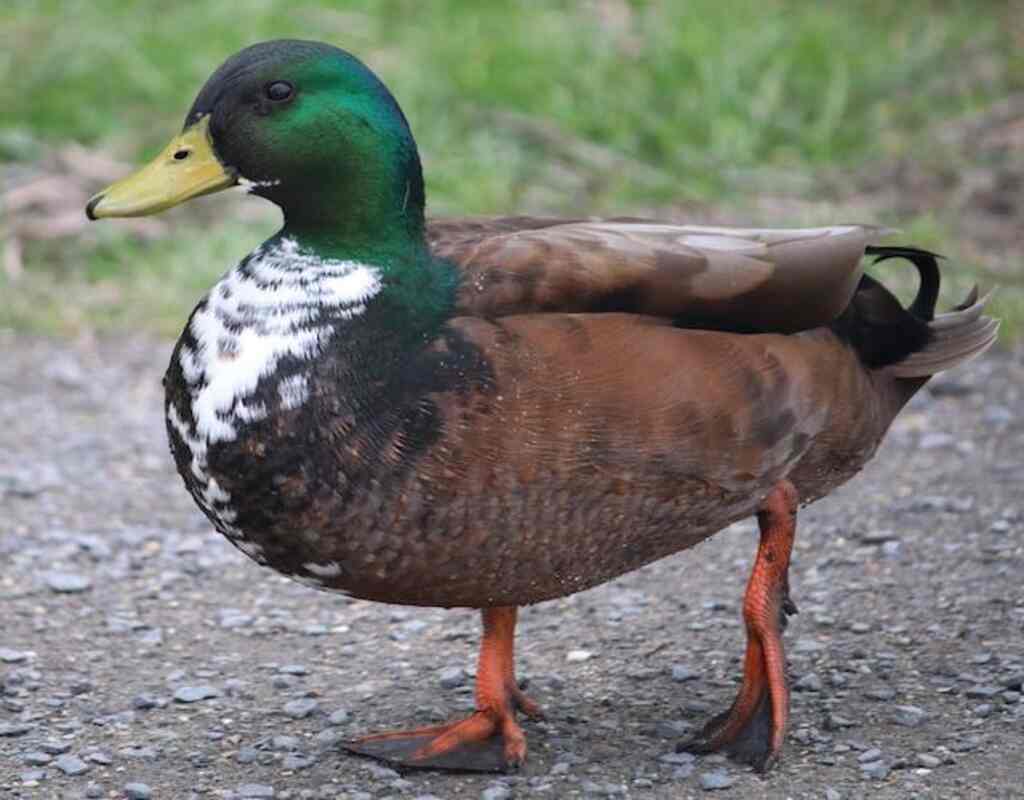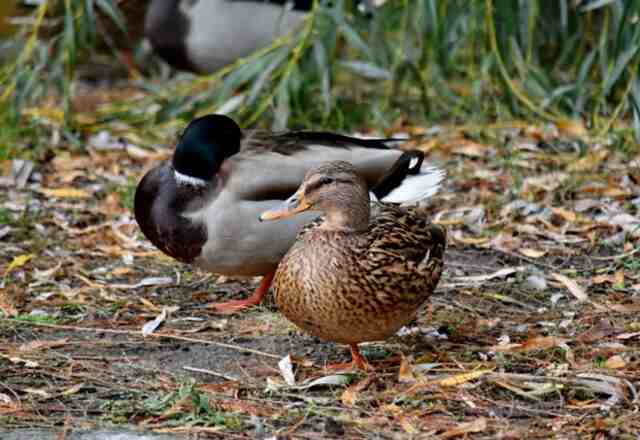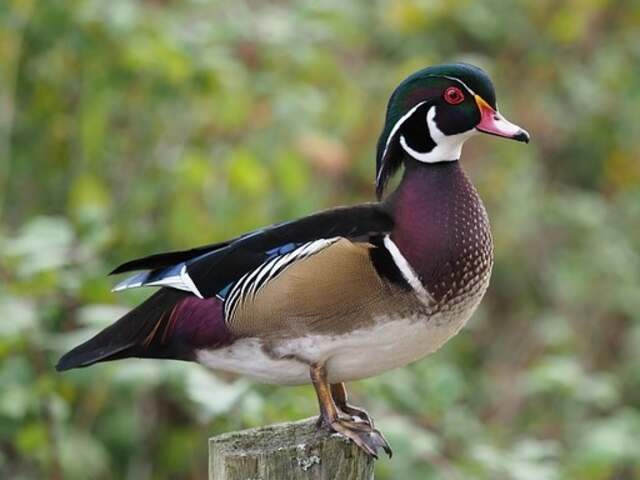Have you ever find yourself observing ducks and wondered why do ducks wag their tails? It’s a common sight to see them shaking their tails while swimming or waddling around, but what’s the reason behind it?
You might assume that it’s just a random movement, but there’s actually a lot more to it than that. In this article, we’re going to explore the different reasons why ducks wag their tails.
From expressing happiness to searching for a mate, these seemingly simple movements have a deeper meaning.
So, if you’re ready to unlock the mysteries of duck behavior and gain a little more insight into the natural world around you, let’s dive in!
Table of Contents
- 1 Reasons for Tail Wagging
- 2 Happy Ducks
- 3 Shaking Off Water
- 4 Self-Calm
- 5 Balance While Walking
- 6 Attracting a Mate
- 7 Cold Ducks
- 8 Excitement
- 9 Cooling Off
- 10 Illness Indicators
- 11 Mating Season
- 12 Waddling Movements
- 13 Science Behind Tail Shaking
- 14 Happiness Signals
- 15 Mate Search
- 16 Frequently Asked Questions
- 17 Conclusion
- 18 Author
Reasons for Tail Wagging
You’ll notice those fluffy little rumps moving back and forth, signaling a range of emotions from excitement to contentment. Tail wagging is a common behavior among ducks, and it’s one way they communicate with each other. Just like humans, ducks have body language that helps them convey their emotions and intentions.
One of the reasons ducks wag their tails is to show their excitement. When a duck is excited, its tail starts wagging vigorously, almost like a dog wagging its tail. This can happen when they see something they like or when they’re about to be fed. So, if you have pet ducks, you may notice their tails wagging when they see you coming with their food.
Another reason ducks wag their tails is to communicate with each other. Just like humans use gestures to convey their thoughts and emotions, ducks use body language, including tail wagging, to communicate with their peers. For instance, a duck may wag its tail to show that it’s not interested in a particular food item or to signal that it’s ready to mate.
Sometimes, ducks wag their tails to show contentment. When a duck is feeling happy and relaxed, it may wag its tail slowly, indicating that it’s enjoying its surroundings. If you have pet ducks, you may notice their tails wagging gently when they’re taking a bath or basking in the sun.
In conclusion, tail wagging is an important aspect of a duck’s body language. It helps them communicate with each other and convey their emotions. So, the next time you see a duck wagging its tail, you know that it’s not just a cute little movement, but a meaningful way of communication.
Happy Ducks
You’re in for a treat as these feathered friends of yours are expressing their joy in the most delightful way! Ducks wag their tails as a sign of happiness.
When they’re content and feeling good, their tails start to dance and sway. It’s a fascinating behavior to observe, and it’s a clear indication that your ducks are in good spirits.
So, what makes ducks happy? Here are three things that could be causing your ducks to wag their tails:
- Plenty of food and water: Ducks are happiest when they have access to clean water and plenty of food. If you make sure to provide them with a steady supply, they’re likely to be happy and content.
- Courting behavior: If you have male and female ducks together, you may notice tail wagging as part of their courting behavior. They may wag their tails to attract a mate, showing off their plumage and their good health.
- A comfortable environment: Ducks are happiest when they have a comfortable and safe place to rest and sleep. If your ducks have plenty of space to roam and a cozy shelter to retreat to, they’re likely to be content and happy.
In summary, tail wagging is a sign of happiness in ducks. If you notice your ducks wagging their tails, it’s a good indication that they’re content and feeling good. Keep them well-fed, provide a comfortable environment, and watch them as they courting each other, and you’ll see plenty of happy tail wagging from your feathered friends!
Shaking Off Water
Watching a duck shake off water is a mesmerizing sight that never fails to make you smile. As a duck emerges from the water, it begins to shake its body vigorously, causing droplets of water to fly everywhere. This water shedding behavior is an essential part of a duck’s routine. By shaking off water, ducks maintain their body temperature and keep their feathers dry, which is crucial for their survival.
However, shaking off water isn’t just a matter of survival for ducks. It’s also a form of communication and body language. When ducks wag their tails, they’re signaling to other ducks that they’re happy and content. Tail-wagging is a way of expressing joy and satisfaction, and it’s no wonder that it’s such a mesmerizing sight to watch.
But tail-wagging isn’t just about communication. It’s also about balance. When ducks shake off water, they need to maintain their balance, especially if they’re standing on one leg. The tail serves as a counterbalance, helping the duck stay upright while it shakes off water. Without that counterbalance, the duck would be at risk of falling over.
In conclusion, watching a duck shake off water isn’t just a simple act of water shedding. It’s a complex behavior that involves communication, body language, and balance. When a duck wags its tail, it’s telling us that it’s happy and content, and it’s also using its tail to maintain its balance.
So, the next time you see a duck shaking off water, take a moment to appreciate the intricate beauty of its movements.
Self-Calm
It’s amazing how a simple act like shaking off water can serve as a form of self-calm for ducks. You see, ducks are social animals that rely heavily on communication and body language to convey their emotions and intentions.
When they feel overwhelmed or anxious, they may start to shake their body vigorously, causing water droplets to fly off in every direction. This self-soothing mechanism helps them release tension and regain their composure, allowing them to maintain their inner peace and emotional balance.
Tail wagging is another behavior that ducks exhibit when they are feeling relaxed and content. You may have noticed that ducks wag their tails when they are floating on the water or preening their feathers. This is a sign that they are feeling safe and comfortable in their surroundings.
Tail wagging is also a way for ducks to communicate with each other, indicating that they are not a threat and are ready to engage in social interactions. It’s fascinating how ducks use body language to convey so much information without uttering a single word!
In conclusion, ducks are fascinating creatures that use a variety of behaviors to express their emotions and maintain their well-being. Shaking off water and tail wagging are just two examples of the many ways ducks self-calm and communicate with each other.
As humans, we can learn a lot from these feathered friends about the importance of taking care of our emotional health and finding healthy ways to cope with stress and anxiety. So, the next time you see a duck wagging its tail, take a moment to appreciate the beauty of nature and the wisdom of these amazing creatures.
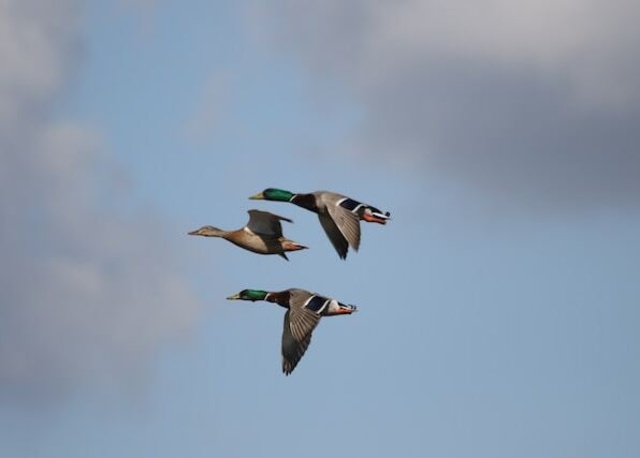
Balance While Walking
As you walk, you may notice how ducks effortlessly maintain their balance on land and water, thanks to their unique way of moving their bodies. When ducks walk, they swing their tails back and forth to maintain balance.
Their tails act as a counterbalance, helping them to keep their center of gravity over their feet. This is especially important when ducks are walking on uneven surfaces or in water with changing currents.
Not only do ducks wag their tails to maintain balance, but they also use their tail movements to communicate with one another. Ducks have a complex system of body language that they use to convey messages such as aggression, submission, and courtship.
When a male duck is trying to attract a mate, he’ll often wag his tail rapidly from side to side. This is a clear signal to the female that he’s interested in her and is ready to mate. The way that ducks move their tails is also an important part of their mating rituals.
During courtship, male ducks will often hold their tails high and fan out their feathers to display their colorful plumage. This is a way of showing off their strength and virility to potential mates.
Female ducks are attracted to males with the brightest feathers and the most impressive tail displays. Their tail movements are an important part of their body language and play a crucial role in their social interactions.
So, the next time you see a duck wagging its tail, remember that there’s much more going on than just a simple balancing act.
Attracting a Mate
You’ve learned that ducks wag their tails to maintain balance while walking. But did you know that tail wagging also plays a significant role in their mating behavior?
When ducks are looking to attract a mate, they’ll often perform a courtship ritual that involves wagging their tails rapidly up and down. This behavior is thought to be a way for the male ducks to display their strength and vitality to potential female partners.
Additionally, tail wagging can also help to increase the amount of water shedding from their feathers, making them appear more attractive and healthy.
However, not all tail wagging in ducks is related to courtship. Sometimes, ducks will wag their tails as a way to relieve stress or tension. This can be particularly common in situations where there is competition for resources or territory. By wagging their tails, ducks can release some of the pent-up energy and anxiety that they may be feeling.
Overall, tail wagging is a fascinating behavior that serves multiple purposes for ducks. Whether they’re trying to attract a mate or simply relieve stress, this movement is an essential part of their natural behavior.
So, next time you see a group of ducks waddling around, pay attention to their tails – you might just learn something new about these fascinating creatures.
Cold Ducks
When the cold sets in, you’ll notice the ducks huddling together for warmth, their feathers fluffed up like cozy blankets. However, did you know that ducks can still get cold and even develop pneumonia? This is why you’ll often see ducks wagging their tails when it’s cold. The tail wagging helps to circulate blood through their bodies, keeping them warm and preventing hypothermia.
Ducks are aquatic birds, and as such, they spend most of their time in water. When it’s cold, the water can become frigid, causing the ducks to become cold and wet. The tail wagging also helps to dry off their backsides, as the feathers in that area are not waterproof. This keeps them from becoming too cold and wet, which can lead to health problems.
As you walk by a group of ducks, you may notice that some of them are wagging their tails more vigorously than others. This could indicate excitement or stress, but in cold weather, it’s often a sign of discomfort.
If you see a duck that is excessively wagging its tail, it’s a good idea to contact a veterinarian or wildlife expert to ensure that the duck isn’t suffering from hypothermia or another health issue.
In conclusion, when the temperature drops, ducks will wag their tails to keep themselves warm and dry. It’s a fascinating survival mechanism that helps them cope with the cold and wet conditions they face in their natural habitats.
So the next time you see a duck wagging its tail, remember that it’s not just a cute quirk – it’s a crucial way for the duck to stay healthy and comfortable.
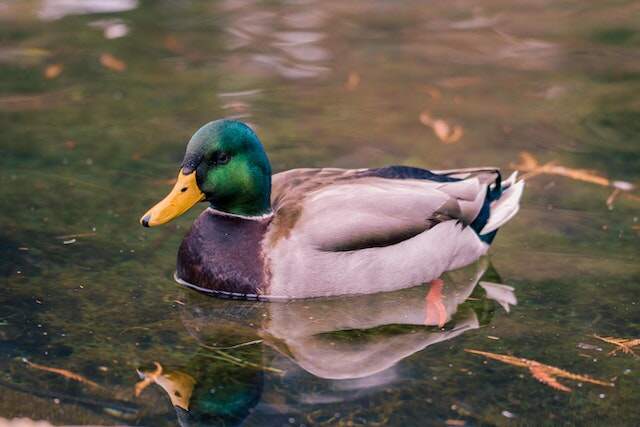
Excitement
Get ready to feel the excitement radiating off these lively ducks as they vigorously wag their tails.
When ducks are excited, their tails wag rapidly from side to side, much like a dog’s tail. Excitement can be triggered by various things, such as the prospect of food or human interaction. When they see their favorite human coming towards them with a bag of treats, they’ll quickly start wagging their tails in excitement.
Water is another trigger that can excite ducks and cause them to wag their tails. Ducks love water, and they get very excited when they see it. Whether it’s a pond, a puddle, or a bathtub, ducks will wag their tails in excitement when they see water. They might even start to splash around and play in the water, which is always a fun sight to see.
Illness can also cause ducks to wag their tails. When they’re sick, they might become excited when they start feeling better. This excitement can manifest itself in the form of a wagging tail. It’s important to note that illness isn’t always the cause of tail wagging, and it’s important to monitor your ducks’ behavior to ensure they’re healthy.
Overall, excitement is the main reason why ducks wag their tails. Whether it’s because of food, water, human interaction, or even illness, ducks will wag their tails when they’re excited. It’s a sign that they’re happy and content, and it’s always a joy to see.
So next time you see a duck wagging its tail, know that it’s just expressing its excitement about the world around it.
Cooling Off
As we learned earlier, ducks wag their tails when they’re excited. However, did you know that they also wag their tails to cool off!
Ducks are semiaquatic birds, which means they live both on land and in water. When they’re in water, they can easily cool off by splashing around or diving in. However, when they’re on land, it’s harder for them to regulate their body temperature.
This is where tail-wagging comes in. By wagging their tails, ducks are able to release heat from their bodies. The movement of their tail feathers helps to circulate air around their bodies, creating a cooling effect.
This is particularly important during hot weather or if a duck is experiencing illness or stress. So, the next time you see a duck wagging its tail, it may not be because it’s excited. It could simply be trying to cool off and regulate its body temperature.
Remember, water is not the only way for ducks to cool off, and tail-wagging is just one of the many ways these amazing birds adapt to their environment.
Illness Indicators
Watch out for the red flags: Ducks may give subtle hints of their well-being through their body language. As a duck owner, it’s important to observe their behavior and recognize any signs of illness.
Here are some illness indicators you should look out for:
- Lethargy – If your duck is unusually inactive or sluggish, it may be a sign of illness. Ducks are typically active animals, so any sudden changes in behavior should be noted.
- Respiratory problems – Ducks are susceptible to respiratory illnesses such as pneumonia. If your duck is wheezing or coughing, it may be a sign of respiratory distress.
- Abnormal droppings – The color, consistency, and frequency of a duck’s droppings can indicate their overall health. If you notice any changes in their droppings, it may be a sign of an illness.
- Self-soothing behaviors – Ducks may engage in self-soothing behaviors such as excessive preening or feather pulling when they are stressed or sick.
Illness in ducks can be caused by a variety of factors including duck viral hepatitis, Newcastle disease, and other viral and bacterial infections. If you suspect your duck is ill, it’s important to seek veterinary care as soon as possible. Early detection and treatment can improve your duck’s chances of recovery.
In summary, it’s important to be aware of your duck’s behavior and recognize any signs of illness. Lethargy, respiratory problems, abnormal droppings, and self-soothing behaviors are all indicators that your duck may be sick. Don’t hesitate to seek veterinary care if you suspect an illness.
Remember, a healthy duck is a happy duck!
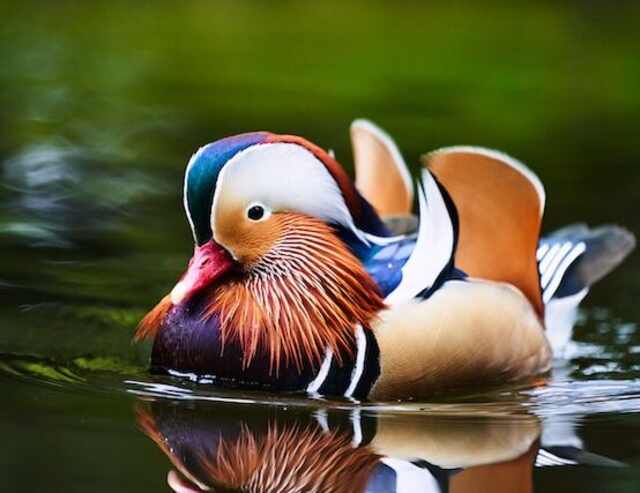
Mating Season
During mating season, you’ll notice your male duck becoming more territorial and aggressive towards other males. This is because male ducks are competing for the attention of female ducks and want to ensure that they are the one chosen for mating.
In addition to aggression, male ducks may also display certain behaviors such as head bobbing, wing flapping, and tail wagging. One of the reasons why male ducks wag their tails during mating season is to show excitement. When a female duck approaches, the male duck may start to wag his tail rapidly as a sign of anticipation.
This behavior is similar to the way a dog wags its tail when it is excited about something. In this sense, tail wagging can be seen as a form of self-soothing for male ducks during the mating process. Another reason why male ducks wag their tails during mating season is to attract the attention of female ducks.
The tail wagging motion is a visual cue that signals to female ducks that the male is interested in mating. This behavior can be particularly effective in the water, as the movement of the tail creates ripples and waves that are eye-catching to female ducks.
In conclusion, tail wagging is just one of the many behaviors that male ducks display during mating season. By wagging their tails, male ducks are able to show excitement, self-soothe, and attract the attention of female ducks. So, the next time you see your male duck wagging his tail, know that he is simply trying to impress the ladies and ensure his place as the dominant male during mating season.
Waddling Movements
When male ducks walk, you might notice their waddling movements that are caused by their legs being set far apart from their bodies, giving them a distinctive gait that can be up to 20 inches wide. This movement is not just for show; it serves a practical purpose.
As ducks waddle, they create ripples in the water, which can help them locate food. This movement also helps them stay balanced while swimming in rough waters, where the waves can be unpredictable.
But waddling can also serve as a form of self-soothing for ducks. When they’re feeling stressed or anxious, they may start to waddle back and forth, which serves as a way to calm themselves down. This behavior is especially common in ducks that are kept in captivity, where they may not have access to natural bodies of water.
Waddling can also be a way for ducks to bond with each other and show their affection. However, it can also make them more vulnerable to predators. Their wide gait can make it difficult for them to escape quickly, and it can also make them more noticeable to predators. For this reason, ducks may only waddle when they feel safe and secure in their environment.
When it comes to mating, male ducks will often wag their tails as a way to attract female ducks. This behavior is part of their courtship ritual, which involves showing off their colorful feathers and performing elaborate displays.
The tail-wagging is a way to signal their readiness to mate and to show off their physical fitness. Female ducks will often choose their mates based on these displays, as they are looking for males who are strong and healthy.
In conclusion, waddling movements in ducks serve a practical purpose, such as helping them locate food and navigate rough waters. It can also serve as a way for ducks to self-soothe and bond with each other. However, it can also make them more vulnerable to predators.
When it comes to mating, tail-wagging is an important part of the courtship ritual, and female ducks will often choose their mates based on these displays. Overall, these behaviors are fascinating to observe and provide insight into the complex social lives of ducks.
Science Behind Tail Shaking
The science behind tail shaking in male ducks is a fascinating display of physical fitness and attraction. Let’s take a closer look at the reasons behind this behavior.
- Self-Soothing: Tail shaking is a natural self-soothing behavior in ducks. When they’re preening or relaxing, they often shake their tails to release tension and feel more comfortable. It’s a way for them to calm themselves and take care of their physical well-being.
- Excitement: Male ducks shake their tails as a display of excitement during courtship. When they’re trying to attract a mate, they’ll often shake their tails and move their heads in a rhythmic motion to show off their physical prowess and attract a female partner. This behavior is essential for mating success and can increase their chances of finding a mate.
- Natural World: Tail shaking is a common behavior in the natural world. Many animals, such as dogs, cats, and horses, will shake their tails as a sign of happiness or excitement. It’s a natural way for animals to communicate and express their emotions. The same is true for ducks, who use their tail shaking as a way to communicate with each other and show their emotions.
- Head Movement: When male ducks shake their tails, they often move their heads in a synchronized motion. This head movement is an important part of the courting display and helps to attract the attention of female ducks. The combination of tail shaking and head movement is a powerful display of physical fitness and attraction and is essential for successful mating.
In conclusion, tail shaking is a fascinating behavior in ducks that serves several purposes. From self-soothing to attracting a mate, tail shaking is an important part of their behavior. As we continue to learn more about the natural world, we can gain a greater appreciation for the behaviors and interactions of animals like ducks.
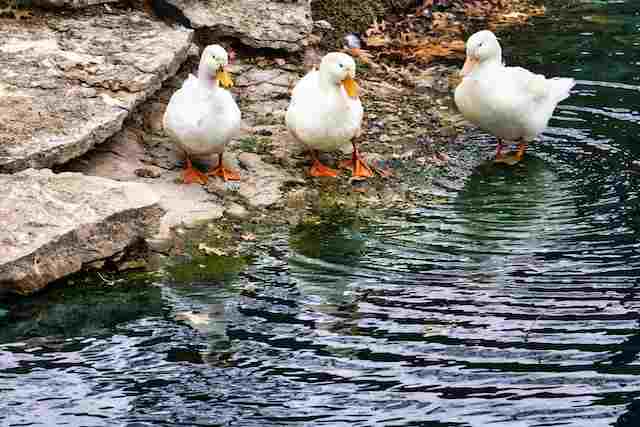
Happiness Signals
Have you ever wondered why ducks wag their tails? In our previous discussion, we learned about the scientific reasons behind tail shaking. But did you know that tail wagging can also be a sign of happiness in ducks?
Yes, you heard that right! In this section, we’ll be discussing how tail wagging is a way for ducks to signal their happiness.
Tail wagging is a common self-soothing behavior in ducks. When ducks are feeling stressed or anxious, they’ll often shake their tails to calm themselves down. It’s their way of releasing tension and redirecting their focus to something more positive.
However, tail shaking can also be seen as an expression of excitement, especially when ducks are playing or exploring new environments.
Aside from self-soothing and excitement, tail wagging can also be a mating behavior. Male ducks will often wag their tails to attract female ducks during courtship rituals. It’s their way of showing off their fitness and strength, which can be appealing to potential mates.
Female ducks, on the other hand, will wag their tails in response if they find a male duck attractive.
In general, tail wagging in ducks is a positive behavior that indicates happiness. Ducks will often wag their tails when they’re content, relaxed, or enjoying their surroundings. It’s a great way for them to communicate their feelings to other ducks and to us humans who observe them.
So, the next time you see a duck wagging its tail, know that it’s a happy duck!
Mate Search
As you observe the ducks in search of a mate, watch for the subtle signals of happiness they display, including the rhythmic movement of their feathered fans. But that’s not all, as they swim in the water, they also wag their tails.
The reason behind this peculiar behavior is that it’s part of their mating ritual. It’s a way of communicating to potential partners, that they’re interested and ready to mate.
Here are three things to keep in mind when watching ducks wag their tails:
- Predators: Ducks are always on the lookout for predators while swimming. The wagging of their tails creates a disturbance in the water that could deter predators from attacking.
- Mating: Tail wagging is a sign of sexual readiness. When a male duck wags his tail, he’s sending a message to the female that he’s ready to mate. If the female is interested, she’ll respond by wagging her tail as well.
- Bobbing head: When a duck bobs its head, it’s a sign that they’re checking out their potential mate. If they like what they see, they may start wagging their tail or performing other flirtatious behaviors.
So, the next time you’re watching ducks, pay attention to their tails. It’s not just a random movement, but a signal of their readiness to mate. It’s a reminder that even in the animal kingdom, courtship and flirting play a crucial role in finding a partner.
Frequently Asked Questions
What is the average lifespan of a duck?
You may be surprised to know that the average lifespan of a duck can vary widely depending on the species. While some ducks may live for only a few years, others can live well into their twenties.
For example, mallards typically live for around 5-10 years in the wild, while muscovy ducks can live for up to 20 years. So, if you’re thinking about getting a pet duck, it’s important to do your research and choose a species that fits your lifestyle and expectations.
Regardless of the species, ducks are fascinating creatures with unique personalities and behaviors that are sure to bring joy and entertainment into your life.
How many different species of ducks are there?
Hey there! Did you know that there are over 120 different species of ducks?
That’s right, these feathered friends come in all shapes, sizes, and colors. From the mallard to the wood duck, each species has its own unique characteristics and behaviors.
Some are known for their diving abilities, while others prefer to stick to the shallows. Regardless of their differences, one thing is for sure, ducks are fascinating creatures that are just waiting to be explored.
So why not take some time to learn about these amazing birds? Who knows, you might just find yourself feeling a little more liberated along the way.
What are some common predators of ducks?
Picture this: a serene pond surrounded by tall grasses and trees, with ducks gliding gracefully on the surface.
But lurking beneath the peaceful surface are predators waiting to strike. Coyotes, foxes, raccoons, and even domestic cats are all common predators of ducks. These predators can attack both adult ducks and their vulnerable young, making it difficult for them to survive in the wild.
As you learn about the dangers that ducks face, you may feel a sense of empathy for these creatures and a desire to protect them from harm.
How do ducks communicate with each other?
As you watch ducks swimming in a pond, have you ever wondered how they communicate with each other?
Well, ducks are quite social creatures and use various methods to communicate. One of the most common ways is through vocalizations such as quacks, honks, and whistles. They also use body language, such as head movements and wing flapping, to convey messages. Additionally, they communicate through visual cues like their bright-colored feathers and patterns.
It’s fascinating to see how these beautiful creatures interact and communicate with each other.
What is the difference between male and female ducks?
If you’re wondering about the difference between male and female ducks, you’ll find that they have distinct physical characteristics.
Male ducks, also known as drakes, have vibrant and colorful plumage, while female ducks, called hens, have more subdued feathers. Drakes also have curled tail feathers, while hens have straight ones.
Additionally, drakes have a raspy, hoarse voice, while hens have a gentler quack.
Knowing these differences can help you identify which ducks you’re seeing in the wild or at the park.
Conclusion
So now you know why ducks wag their tails! It’s not just a random movement, but rather a way for them to communicate their emotions and maintain balance while walking.
Next time you see a duck wagging its tail, take a moment to appreciate the beauty and complexity of nature. Imagine sitting by a pond on a warm summer day, watching a group of ducks swim and play.
As they wag their tails in happiness and shake off water, you can’t help but feel a sense of joy and contentment. The simplicity of the moment and the natural beauty of the ducks serve as a reminder to appreciate the small things in life.

